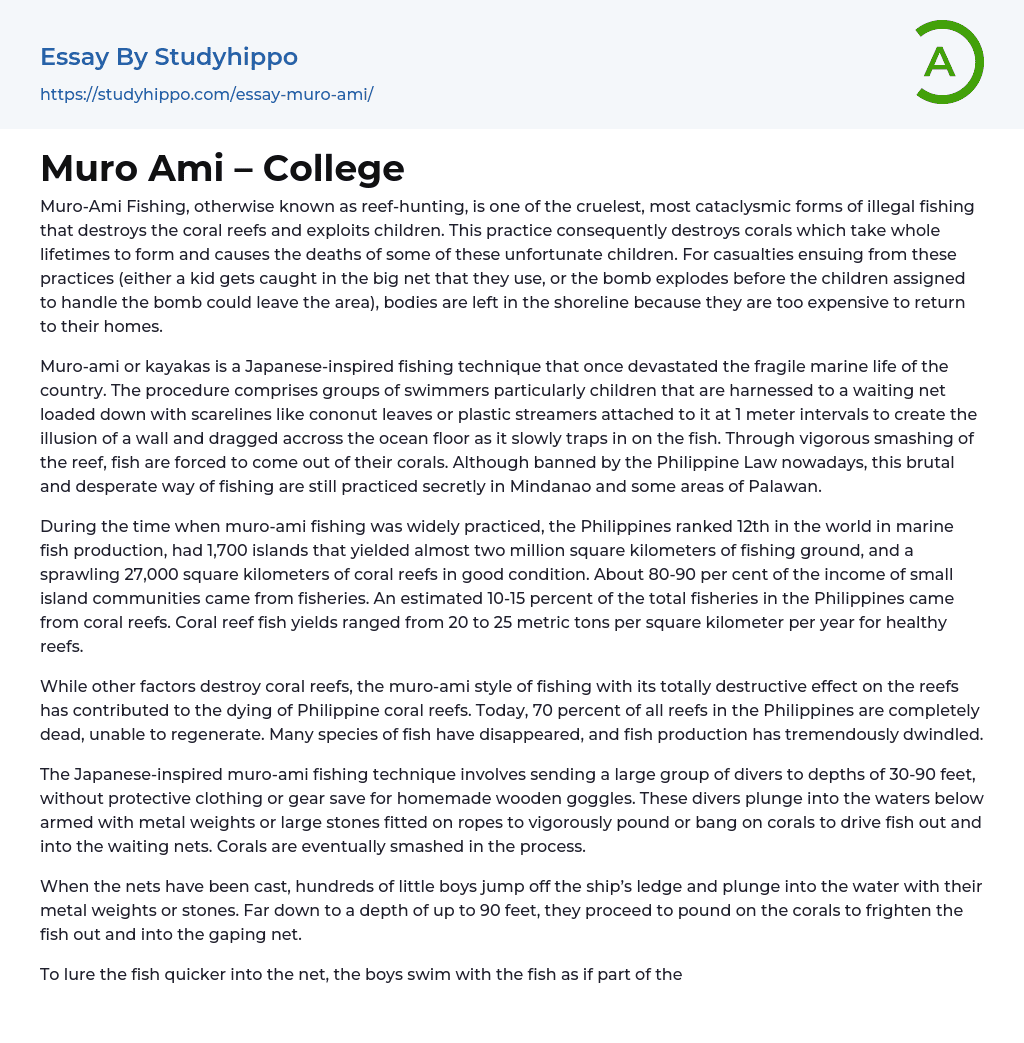Muro-Ami Fishing, otherwise known as reef-hunting, is one of the cruelest, most cataclysmic forms of illegal fishing that destroys the coral reefs and exploits children. This practice consequently destroys corals which take whole lifetimes to form and causes the deaths of some of these unfortunate children. For casualties ensuing from these practices (either a kid gets caught in the big net that they use, or the bomb explodes before the children assigned to handle the bomb could leave the area), bodies are left in the shoreline because they are too expensive to return to their homes.
Muro-ami or kayakas is a Japanese-inspired fishing technique that once devastated the fragile marine life of the country. The procedure comprises groups of swimmers particularly children that are harnessed to a waiting net load
...ed down with scarelines like cononut leaves or plastic streamers attached to it at 1 meter intervals to create the illusion of a wall and dragged accross the ocean floor as it slowly traps in on the fish. Through vigorous smashing of the reef, fish are forced to come out of their corals. Although banned by the Philippine Law nowadays, this brutal and desperate way of fishing are still practiced secretly in Mindanao and some areas of Palawan.
During the time when muro-ami fishing was widely practiced, the Philippines ranked 12th in the world in marine fish production, had 1,700 islands that yielded almost two million square kilometers of fishing ground, and a sprawling 27,000 square kilometers of coral reefs in good condition. About 80-90 per cent of the income of small island communities came from fisheries. An estimated 10-15 percent of
the total fisheries in the Philippines came from coral reefs. Coral reef fish yields ranged from 20 to 25 metric tons per square kilometer per year for healthy reefs.
While other factors destroy coral reefs, the muro-ami style of fishing with its totally destructive effect on the reefs has contributed to the dying of Philippine coral reefs. Today, 70 percent of all reefs in the Philippines are completely dead, unable to regenerate. Many species of fish have disappeared, and fish production has tremendously dwindled.
The Japanese-inspired muro-ami fishing technique involves sending a large group of divers to depths of 30-90 feet, without protective clothing or gear save for homemade wooden goggles. These divers plunge into the waters below armed with metal weights or large stones fitted on ropes to vigorously pound or bang on corals to drive fish out and into the waiting nets. Corals are eventually smashed in the process.
When the nets have been cast, hundreds of little boys jump off the ship’s ledge and plunge into the water with their metal weights or stones. Far down to a depth of up to 90 feet, they proceed to pound on the corals to frighten the fish out and into the gaping net.
To lure the fish quicker into the net, the boys swim with the fish as if part of the catch. With lungs about to burst, they have a few seconds to escape the net before it closes up. The unlucky ones that are not able to get out in time come up to the surface along with the catch, lifeless. The luckier ones, having proven their gift
of agility to their sea masters, spend the rest of their lifetime hearing-impaired or maimed. The top crop only have to fight extreme exhaustion, after pushing the limits of their endurance.
Muro-ami fishing trawlers, mostly unseaworthy, stay out at sea for up to ten months. They roam the seas and drop anchor in areas of coral reefs and atolls. The stinking, unsanitary, and cramped quarters are often packed with as many as 400 to 500 adult crew and little boys as young as 7 years old.
The net is cast anywhere between 7 and 10 times a day, with the children working from 6am to 5pm. The harsh adult crew would whip and lash at the kids if the nets didn’t produce fifty to seventy big containers of fish in every dive. In some occasions, the boys are made to stand under the sun for hours as punishment. When these fishing trawlers encounter Navy patrols out at sea, the children are confined and hidden in the engine room for days. The kids are made to work even on days that they are ill.
The children divers, usually on a ten-month contract, are promised to be paid at the end of the contract. Their food budget on board, however, is deducted from their salary of 20 pesos a day, even if food is extremely limited on most days. The kids and their families find out after the ten-month contract, when the trawler comes back to the island to discharge the kids, that they have no payment left.
- Professor essays
- Should College be Free essays
- Should college athletes be paid essays
- College Education essays
- College Tuition essays
- Graduation essays
- College Goals essays
- Personal Statement essays
- Online Classes Vs Traditional Classes essays
- Online Education essays
- Student Loan essays
- Study Abroad Scholarship essays
- Reasons To Go To College essays
- Paying College Athletes essays
- Technology In The Classroom essays
- Freshwater Fishing essays
- Classroom essays
- College essays
- E-Learning essays
- Elementary School essays
- Examination essays
- Graduate School essays
- High School essays
- History Of Education essays
- Homeschooling essays
- Kindergarten essays
- Middle School essays
- Public School essays
- School essays
- Single Sex Schools essays
- Special Education essays
- Student essays
- Teacher essays
- University essays
- Vocational Education essays
- Atmosphere essays
- Biodiversity essays
- Coral Reef essays
- Desert essays
- Earth essays
- Ecosystem essays
- Forest essays
- Lake essays
- Natural Environment essays
- Ocean essays
- Oxygen essays
- Rainbow essays
- Sea essays
- Soil essays
- Volcano essays




